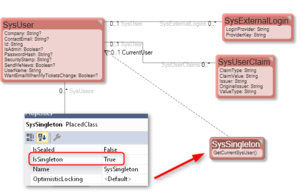No edit summary |
(Updated Edited template to July 12, 2025.) |
||
| (6 intermediate revisions by 2 users not shown) | |||
| Line 1: | Line 1: | ||
<message>Write the content here to display this box</message> | |||
There is an operator in OCL you may not know about yet: oclSingleton. | |||
''Use it like this:'' Class1.oclSingleton <and follow with operations or navigations on that single instance> | |||
If Class1 does not have an instance at the time of executing the oclSingleton, one is created. | |||
To use this, set the taggedvalue on Class1 “Eco.IsSingleton” to “true”. | |||
It is a very practical design pattern to have a modeled Singleton class – this removes the need for other global variables – like logged-in user, etc. Since the Singleton class can have code-derived attributes and associations, you can pick up important info from the running environment and make it available in the model context. Try it – it will make your code less hairy. | |||
oclSingleton is an operator that helps you implement the Singleton pattern (the pattern states that there is exactly one instance of this class - never more, never less). | oclSingleton is an operator that helps you implement the Singleton pattern (the pattern states that there is exactly one instance of this class - never more, never less). | ||
If you mark a class with IsSingleton=true you can use this oclSingleton operator to get access to the only object instance of this class. | If you mark a class with IsSingleton=true, you can use this oclSingleton operator to get access to the only object instance of this class. | ||
Class: SysSingleton | === '''Example:''' === | ||
'''Class:''' SysSingleton | |||
Common expression: SysSingleton.oclSingleton.CurrentUser.IsAdmin -- this expression looks up the only SysSingleton instance that acts as a Global variable that points out the CurrentUser. | '''Common expression:''' SysSingleton.oclSingleton.CurrentUser.IsAdmin -- this expression looks up the only SysSingleton instance that acts as a Global variable that points out the CurrentUser. | ||
[[File:2017-08-07 21h31 37.png|none|thumb]] | [[File:2017-08-07 21h31 37.png|none|thumb]] | ||
[[Category:OCLOperators]] | [[Category:OCLOperators]] | ||
{{Edited|July|12|2025}} | |||
Latest revision as of 05:58, 20 January 2025
There is an operator in OCL you may not know about yet: oclSingleton.
Use it like this: Class1.oclSingleton <and follow with operations or navigations on that single instance>
If Class1 does not have an instance at the time of executing the oclSingleton, one is created.
To use this, set the taggedvalue on Class1 “Eco.IsSingleton” to “true”.
It is a very practical design pattern to have a modeled Singleton class – this removes the need for other global variables – like logged-in user, etc. Since the Singleton class can have code-derived attributes and associations, you can pick up important info from the running environment and make it available in the model context. Try it – it will make your code less hairy.
oclSingleton is an operator that helps you implement the Singleton pattern (the pattern states that there is exactly one instance of this class - never more, never less).
If you mark a class with IsSingleton=true, you can use this oclSingleton operator to get access to the only object instance of this class.
Example:
Class: SysSingleton
Common expression: SysSingleton.oclSingleton.CurrentUser.IsAdmin -- this expression looks up the only SysSingleton instance that acts as a Global variable that points out the CurrentUser.

